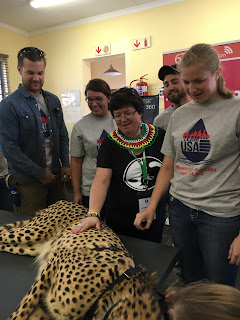Friday, July 15, 2016
Celebration Dinner and Program
If you read yesterday's post about installation, you will know that things ran very late and we had to hustle to get back to the hotel and cleaned up for the closing dinner. For me, if was one of the few times during the week when I felt an abrupt change of pace and had to acknowledge that our time was almost at an end. I think most of us felt this on some level--partly because of some degree of exhaustion and the emotions of the day, since we were finally able to be in our community.
I had told our team early in the week that I had not expected to fall in love with Africa. I told them that I might reach the end of the week and not be ready to leave. That is what happened to me. I wanted very much to see the rest of my family and to see my home, but I also know that I have found a place that is profoundly important to me. Doug said several times during the week that he realized he had not seen me so happy in a very long time--he says ten years. That is something I need to figure out for myself going forward. My summers in Alaska were very similar to this for me--those people ad that land has also lodged themselves very deeply in my heart and soul--hence the large readership of this blog from the great north that I have noted before. This experience has been even deeper for me. I will write more about that in upcoming posts--if only to help myself figure this out.
We had a wonderful time with old and new friends and some wonderful entertainment from the Diepsloot Arts and Culture Network. Some of it echoed the performances from the opening ceremonies, but it all had so much more impact now, after our week on site.
Grant Stewart was our MC for the evening. He introduced Adrian Welke and David Donald from Healthhabitat, who summarized some of their take-aways from the week and highlighted the strengths or unigue elements of each team's design. For Team USA, as we had hoped, they highlighted our modular design, which is intended to make it much easier to replace or provide maintenance to broken units by having the toilet mounted on a skid which can be removed easily without bringing a large truck or crane onsite. They said that the potential of this option had been brought home to them by the two days of installations.
Grant reminded the audience of the "gift" that Paul Pholeros gave to each participant last year. He gave each team member a small piece of pipe to remember School 125. This year each participant--each champion, as Grant reminded us--got this plaque:
The message was unanimous--all the teams and the community were victors in this project. The CPC has been unique throughout its short life in merging competition, collaboration, and leadership development. This year the fruits of that were clear all week--the teams worked together and learned so much, about design, about plumbing, about workplace safety, about culture and history--and the end result was a potent beginning of a relationship with a vibrant and unusual community.
At the World Plumbing Conference in September, some preliminary data on how the eight units are performing will be shared. In one respect, that will indicate a "winner." I am going to revisit the question I asked earlier in this blog--Who Do We Play For? after I get done writing about the trip as a whole, but I would stress that everyone contributed and everyone won in this collaborative competition. We all learned so much and benefited in so man ways.
At the World Plumbing Conference in September, some preliminary data on how the eight units are performing will be shared. In one respect, that will indicate a "winner." I am going to revisit the question I asked earlier in this blog--Who Do We Play For? after I get done writing about the trip as a whole, but I would stress that everyone contributed and everyone won in this collaborative competition. We all learned so much and benefited in so man ways.
I have not told you a great deal about Pat and Alan, from Singapore. For the past three years they have worked with young students, from Singapore and now from Diepsloot, to capture and document the Community Plumbing Challenge. Pat has said on Facebook that she is not a plumber (neither am I!) but the art that she and Alan create carries the heart of this project out into the world. Their video carries the seeds of change:
After this the whole community--old and new friends--a rainbow of people danced. I cannot imagine a better way to end the week.






















































